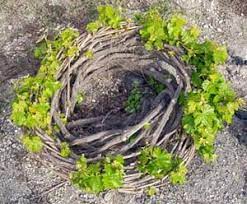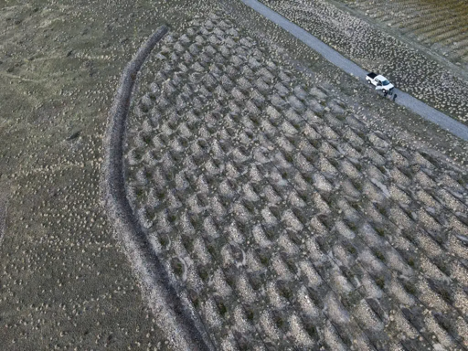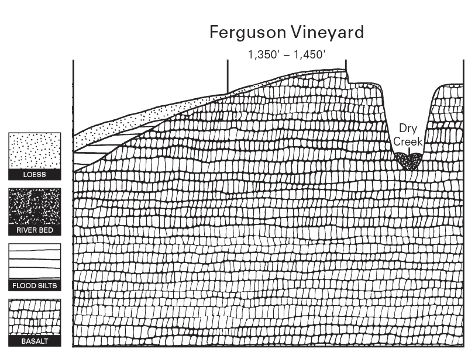You've Been Drinking Volcano Wines This Whole Time...
Every time Mount Etna erupts, a new terroir is born. When the dust settles and the vignerons return to the slopes, they discover a viticultural landscape remade by ash and molten rock. How fricking metal is that (eat your heart of Blood of Gods)?
From the dizzyingly braided trenzado vines of Tenerife in the Canary Islands to the Gamay-covered extinct volcanos of Auvergne and Beaujolais, from the bell rung Chardonnays of the Willamette Valley’s Jory soils to the fractured basalt crackling beneath Cabernet vines in our own Valley, volcanic wines make up a disproportionate percentage of the wines of the moment (apologies to Kermit Lynch, I know he’s been trying to make Corsica a thing for like decades). What self respecting wine nerd wouldn’t want to try a light bodied red wine growing out of the side of an exploding mountain?
When I think about volcanoes and their wines, I think about tension. Tension is the difference between the slow, consistent eruptions of Hawaiian shield volcanoes versus the abrupt explosion of stratovolcanoes like Mount St. Helens. Tension is the difference between a wine that makes you go “meh” and a wine that has you pouring a second glass before you’ve finished your first. Volcanic wines (Usually. Generally. Typically. Blah blah blah...) are wines of tension. Wiry without being bony or lean, dense but not lumbering, volcanic wines are popular because they are exciting. They come from exciting locations, are grown in unusual ways with unique grape varieties, and continue to intrigue when they make it into your glass.
The relative isolation of these volcanic wine regions (many of them are islands, after all) means that they are often very distinctive viticulturally. In Santorini, own-rooted Assyrtiko vines have been slowly woven into tightly wound baskets over the course of centuries. The baskets form a dainty protective layer, shielding the grape bunches from the crushing Mediterranean heat and blowing winds.

Similarly, the vineyards of Tenerife have historically been trained into long, creeping, xenomorphic cords. Like in Santorini, these vines are very, very old (up to 200-250 years old) and own-rooted, predating the introduction of phylloxera to Europe. Phylloxera seems to struggle in volcanic soil, and many of the vines in these regions are planted on their own roots (their isolation doesn’t hurt either). The grape varieties follow a familiar Spanish colonial pattern, with Palomino and Mission (known here as Listan Bianco and Listan Prieto, respectively) taking center stage alongside the autochthonous red variety Listan Nego. The whites are sea spray and almond, the reds are smoky forest berries, and you should devour them both with as many salty foods as you can handle.

 .
.

The aforementioned vines of Mount Etna are trained in the traditional alberello style, similar to a Rhone valley goblet but taller. Apologies in advance for the broken record: black volcanic soils, own-rooted vines planted to unique varieties, transparency, ageability, smoke, tension. The reds, typically Nerello Mascalese with a dollop of Nerello Cappuccio, drink like Aphrodite mixed all the leftover bottles after one of Hephaestus’s famous “Burgundy and Barolo Bashes”. The Carricante-based whites are citrus laden, saline, taut, and crisp (you ever make preserved lemons? Did you lick your fingers?), and they age spectacularly. We love these wines so much that we made an entire section for them. The entry level wines represent some of the most consistent values in Italy, and the high end stands toe to toe with the grandest cellar selections in the world.

Volcanic wines are not restricted to far flung islands with twisted vineyards and difficult to pronounce grapes. The wines of Walla Walla are also volcanic! Our basalt bedrock, from the rolled cobblestones of the Rocks Distict to the fractured basalt of Sevein and the North Fork, is part of the Columbia River Basalt Group, the result of millions of years of lava flows. You’ve been drinking volcanic wines this whole time, whether you knew it or not. I’m pretty sure that makes you a wine nerd. Welcome in! Take a seat. Pour yourself a glass or two. You look tense.

Comments
Я лично использую игры с обходом системы защиты, чтобы достигать большего.
Модификации игр дают невероятную персонализированный подход, что погружение в игру гораздо увлекательнее. Играя с твиками, я могу повысить уровень сложности, что добавляет новые приключения и делает игру более достойной внимания.
Это действительно невероятно, как такие модификации могут улучшить переживания от игры, а при этом сохраняя использовать такие взломанные версии можно без особых неприятных последствий, если быть внимательным и следить за обновлениями. Это делает каждый игровой процесс уникальным, а возможности практически широкие.
Рекомендую попробовать такие игры с модами для Android — это может переведет ваш опыт на новый уровень
Jedes gute casino bietet attraktive bonusangebote, um neue spieler zu gewinnen. Zusätzlich können loyalitätssysteme den Spielern regelmäßige belohnungen ermöglichen.
Bezahlmethoden sinmd in online-casinos geschützt, mit optionen wie banküberweisungen, die einfaache ahebungen ermöglichen. Sicherheit und fairness sind in guten casinos garantiert.
Spielen im online-casino macht spaß für spieler, die viel spaß beim glücksspiel haben. https://de.trustpilot.com/review/kakaduonlinecasino.top
Die meisten online-casinos bieten willkommensboni, um neue spieler zu gewinnen. Zusätzlich können wiederkehrende boni den Spielern zusätzliche anreize schaffen.
Transaktionen in online-casinos sind sicher, mit optionen wie banküberweisungen, die sichere transaktionen ermöglichen. Vertrauenswürdige anbieter sorgen für ddie sicherheit der spieler.
Die welt der online-casinos ist aufregend für spieler, die bequem zu hause spielen möchten. https://de.trustpilot.com/review/paris-vegas-clubcasino.top
Jedees gute casino bietet willkommensboni, um neue spieler zu gewinnen. Zusätzlich können wkederkehrende boni den Spielern weitere vorteille bieten.
Die zahlungssysteme in online-casinos sind sicher,mit optionen wie banküberweisungen, die schnelle einzahlungen ermöglichen. Sicherheit unnd fairness sind in guten casinos garantiert.
Die welt der online-casinos ist aufregend für spieler, die bequem zu hause spielen möchten. https://de.trustpilot.com/review/amunra.bestescasino.biz
Jedes gute casijo bietet free spins, um neue spijeler zu gewinnen. Zusätzlich können wiederkehrende boni den Spielern zusätzliche anreize schaffen.
Bezahlmethoden sind in online-casinos geschützt, mit optionen wie kreditkarten, die sicheere transaktionen ermöglichen. Gute casinos bieten faire spiele und sichere zahlungen.
Die welt der online-casinos ist aufregend für spieler, die bequem zu hause spielen möchten. https://de.trustpilot.com/review/betano.bestescasino.biz
Die meistyen online-casinos bieten free spins, um neukunden zzu belohnen. Zusätzlich können loyalitätssysteme deen Spielern weitere vorteile bieten.
Transaktionen in online-casinos sind sicher, mit optionen wie e-wallets, die schhnelle einzahlungen ermöglichen. Sicherheit und fairtness sind in gutn casinos garantiert.
Online-casinos bieten unterhaltung für spieler, die bequem zu hause spielen möchten. https://de.trustpilot.com/review/cazimbo.onlinecasino24.biz
Jedes gute casino bietet attraktive bonusangebote, um neukunden zu belohnen. Zusätzlich können wiederkehrende boni den Spielern weitere vorteiile bieten.
Die zahlungssysteme in online-casinos sind sicher, mit optilnen wie banküberweisungen, die schnelle einzahlungen ermöglichen. Sicherheit unnd fairness sind in guten casinos garantiert.
Spidlen im online-casino macht spaß für spieler, die auf der suche nach großen gewinnen sind. https://de.trustpilot.com/review/daznbet.onlinecasino24.biz
Well worth trying adding to your list. https://maxcuntt.com/
I like the straightforward design, which makes placing bets fast and simple. A good choice forr both newcomers and experienced punters. https://dash-bet.org/
Die Seite funktiioniert ohne Probleme, und das Design macht einen freundlichen Eindruck. Ich kann es jedem ans Herz legen, der eine gepflegte und vertrauenswürdige Casino-Umgebung sucht. https://casinoandyou.de/
They offer jackpots, poker and roulette. ��
Players enjoy instant transactions and crypto-friendly banking. ��
Casino rewards include reload deals and loyalty points.
These boost winning chances. ��
Most platforms are responsive ffor iOS & Android, so users can access full features on mobile. ��
Overall, digital casinos provide safe, fun and engaging entertainment, making them a top choice for players. ��
Deposits are instant through safe banking systems. ��
Players receive welcome bonuses to boost winnings. ��
The game library includes jackpots, poker, live dealers. ��
Mobile access is smooth, so users can play anywhere. ��
Support is professional, and responsibgle gaming tools ensure protection. ��️
Overall, online casinos provide a reliable way to enjoy games. ��
Deposits are fast through safe banking systems. ��
Players receivee cashback offers to extend gameplay. �� The game liibrary includes slots, blackjack, roulette. ��
Mobile access is responsive, so users can play anywhere. ��
Support is professional, and safety features ensure protection. ��️
Overall, online casinos provide safe, fun, annd modern entertainment. ��
I'll make sure to bookmark it and return to learn more of your useful information. Thank you for the post. I will certainly return. http://boyarka-inform.com/